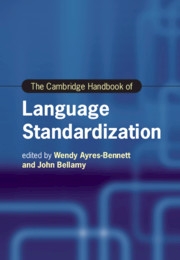Book contents
- The Cambridge Handbook of Language Standardization
- cambridge handbooks in language and linguistics
- The Cambridge Handbook of Language Standardization
- Copyright page
- Contents
- Figures
- Tables
- Contributors
- Introduction
- Part I Revisiting Models and Theories of Language Standardization
- Part II Legitimacy, Authority and the Written Form
- Part III Norms, Literacy and Education
- Part IV Beyond the National
- 19 Transnational Standards of Languages
- 20 Standardization across State Boundaries
- 21 Language Modernization in the Chinese Character Cultural Sphere
- 22 Linguistic Norms, Centre–Periphery Dynamics and the Tension between Uniformity and Diversity in Processes of Standardization
- 23 When Ethnic Boundaries and Language Boundaries Mismatch
- 24 The Standardization of a Stateless Language
- Part V Standardization in Late Modernity
- Name Index
- Subject Index
- References
23 - When Ethnic Boundaries and Language Boundaries Mismatch
Standardization in Mayan Languages in Multilingual Situations
from Part IV - Beyond the National
Published online by Cambridge University Press: 01 July 2021
- The Cambridge Handbook of Language Standardization
- cambridge handbooks in language and linguistics
- The Cambridge Handbook of Language Standardization
- Copyright page
- Contents
- Figures
- Tables
- Contributors
- Introduction
- Part I Revisiting Models and Theories of Language Standardization
- Part II Legitimacy, Authority and the Written Form
- Part III Norms, Literacy and Education
- Part IV Beyond the National
- 19 Transnational Standards of Languages
- 20 Standardization across State Boundaries
- 21 Language Modernization in the Chinese Character Cultural Sphere
- 22 Linguistic Norms, Centre–Periphery Dynamics and the Tension between Uniformity and Diversity in Processes of Standardization
- 23 When Ethnic Boundaries and Language Boundaries Mismatch
- 24 The Standardization of a Stateless Language
- Part V Standardization in Late Modernity
- Name Index
- Subject Index
- References
Summary
Standardization in multilingual situations entails more challenging social scenarios due to the complexity inherent in the identification of particular varieties in the community’s linguistic repertoire as different languages. Based on four case studies from Mayan languages spoken in Guatemala, this chapter shows how speakers of Mayan languages have implemented sometimes opposed standardization strategies according to their local history, ethnic landscape, sociopolitical context and sociolinguistic economy. The studies show that success is predicated upon adaptation, first, to the social roles of linguistic variation in particular regional, multilingual spaces, and second, to the local, existing writing practices. It also requires dialogue and flexibility by the communities and institutions involved. From the unification of mutually unintelligible varieties under one pan-regional standard to the establishment of different standardized varieties for otherwise mutually intelligible regional vernaculars, standardization processes of Mayan languages in Guatemala are as diverse as the sociopolitical and sociolinguistic contexts in which each language is spoken. Failed or contested standardization is, on the other hand, a result of attempts to impose a single model of standardization on communities with heterogeneous histories and unique articulations of ethnic identity and linguistic variation.
Keywords
- Type
- Chapter
- Information
- The Cambridge Handbook of Language Standardization , pp. 621 - 644Publisher: Cambridge University PressPrint publication year: 2021



